Monarch butterflies are heading our way, but their numbers are likely to be down this year. Climate change–combined with habitat loss and other threats–dealt a heavy blow to the population, which enjoyed a celebrated threefold increase last fall.
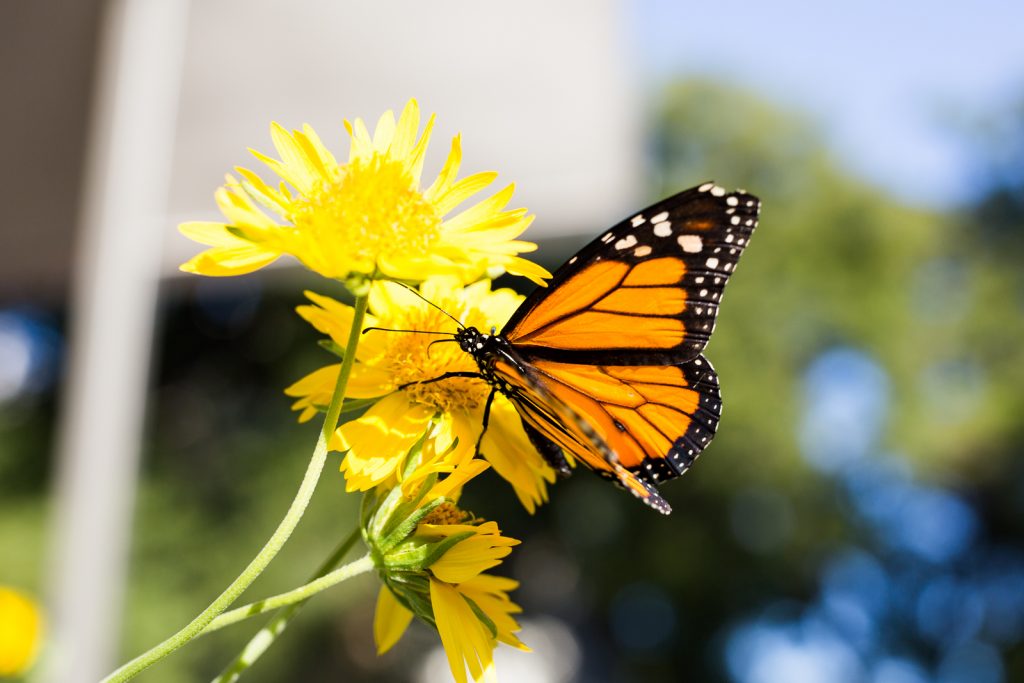
Monarch butterflies are heading our way, but not as many as we had hoped. Monarch on Cowpen daisy. Photo by Scott Ball
The weekend of March 8-9 proved to be a deadly setback for Monarchs. Just as they were heading to Texas from their winter roosts in Michoacán to create the first generation of 2016, a freak ice storm hit the forest where they overwinter. The frigid wind and weather killed an estimated 6.2 million butterflies–about 7.4 percent of the 84 million roosting there, Mexico’s attorney general for environmental protection Alejandro Del Mazo told the Associated Press this week.
Even worse, the storm destroyed 133 acres of the Oyamel fir forest which serves as the Monarchs’ winter home as well as habitat to hundreds of species of birds, mammals, vascular plants and mushrooms. That lost canopy will take years, perhaps decades, to recover. And its service as a protective, insulating blanket for the Monarchs and other wildlife may be gone forever.

Millions of Monarch butterflies froze to death in the March storm in Michoacán. Photo via Monarca via Facebook
The iconic insects make one of the most remarkable annual migrations on the planet, traveling up to 2,800 miles from Mexico through the United States to Canada and back over multiple generations.
Their journey starts in March where they spend the winter in the Oyamel fir forests. After a cue from the sun, they head to Texas where they lay their first generation of eggs on milkweed plants—the only plant they use to breed. Those eggs hatch into caterpillars who grow into butterflies that continue the cycle over the summer, with fourth or fifth generation butterflies returning to Mexico in the fall to overwinter–having never been to the specific roosting site where their ancestors launched the journey. The following spring, those butterflies begin the cycle anew.
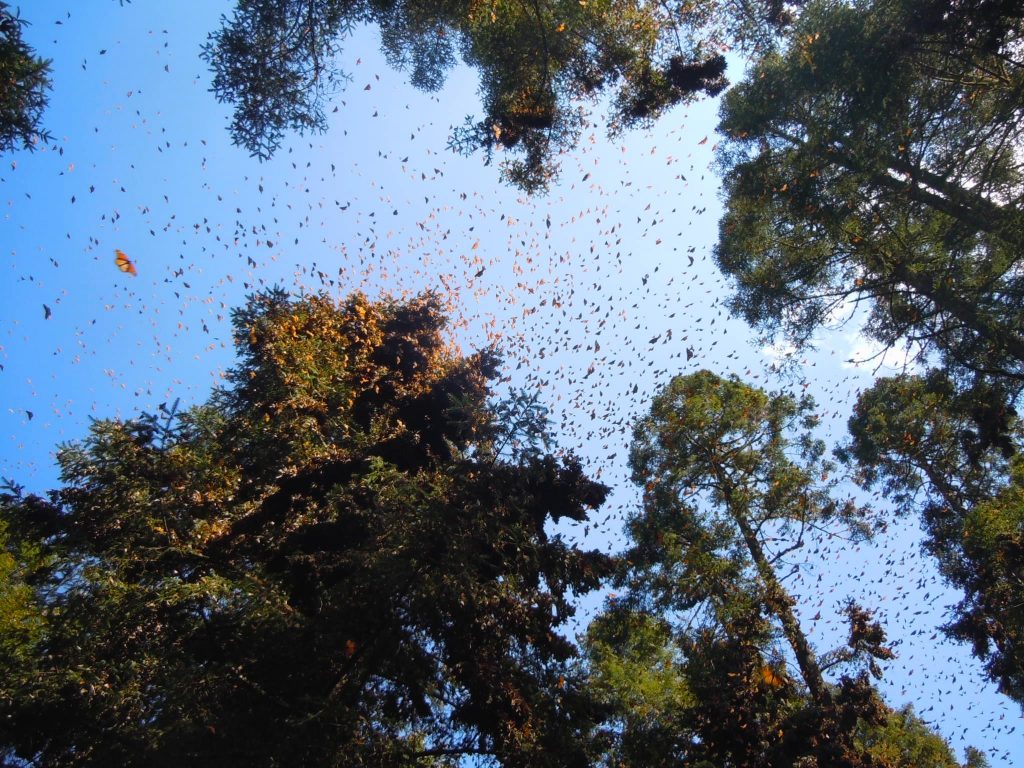
The freak ice and wind storm destroyed 135 acres of their roosting forest. Photo by Monika Maeckle
According to a brief released by the World Wildlife Fund on August 23, the protected forest lost to the March sleet storm was four times that destroyed by illegal logging last year. Here’s the breakdown: of the 179 acres of forest lost in the last year in the core zone of the Monarch Butterfly Biosphere Reserve, 29.5 acres were destroyed by illegal logging, 133 acres by wind-fallen trees during the storm, and 16 acres by drought.
Experts agree that the ice storm got the season off to a bad start. Those of us who follow Monarchs noticed far fewer this spring, as the depleted population made its way north. We hoped they would recover in the summer breeding grounds.
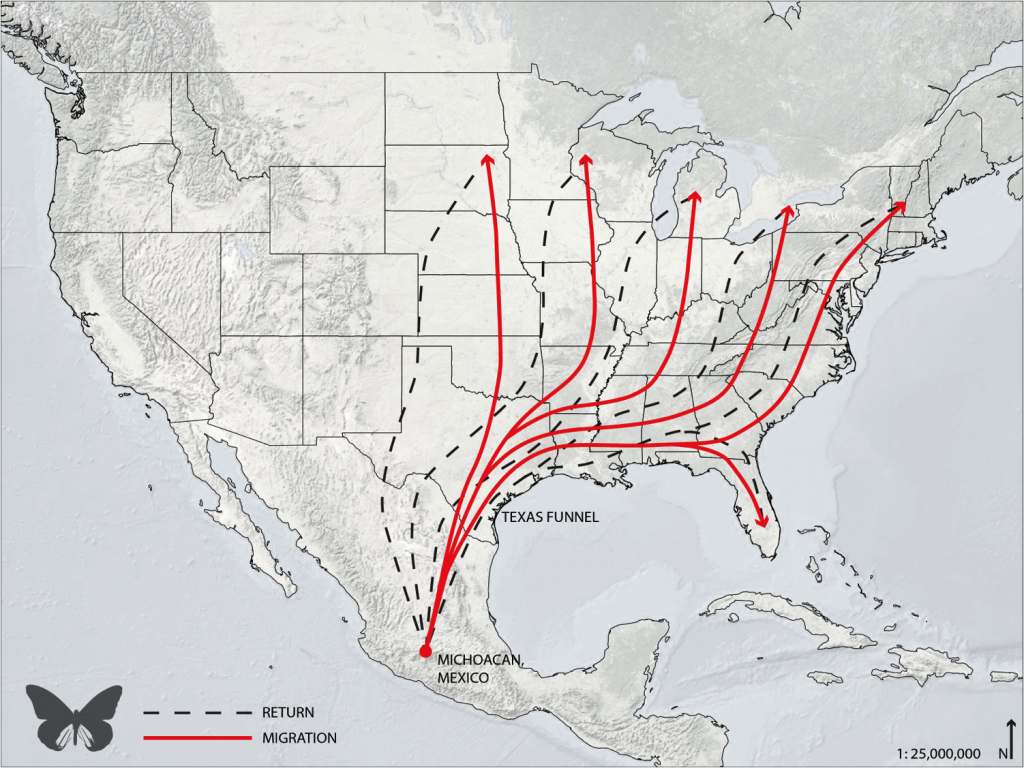
The Monarch migration moves the iconic butterflies through the entire Eastern United States over the course of the summer. Graphic by Nicolas Rivard
“Normally I collect eggs in the spring and I was down about 65% percent over seasons’ past,” said Cathy Downs, Education Outreach specialist for Monarch Watch, the University of Kansas at Lawrence-based organization that runs the citizen science tagging program that tracks the migrating butterflies. Downs operates out of Comfort, Texas, just outside San Antonio. “I would definitely say this was a really, really down spring.”
Further up the migratory path, social media posts from the summer breeding grounds bemoaned the general lack of Monarch butterflies.
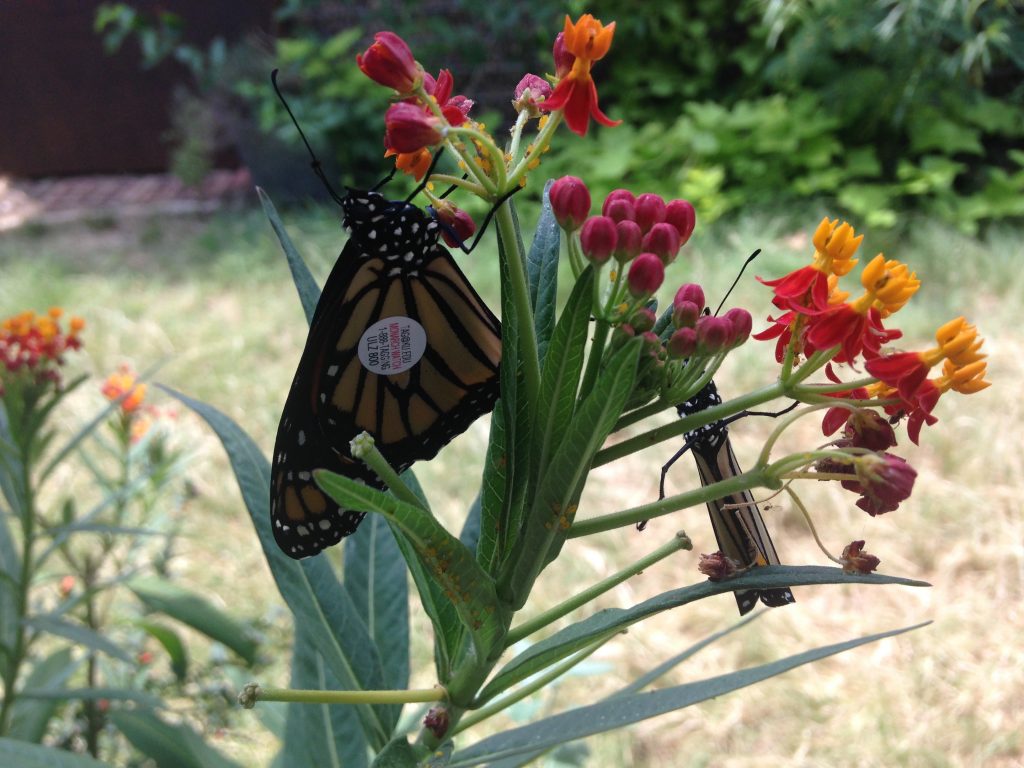
Looking forward to seeing more of these guys. Photo by Monika Maeckle
“I only saw one Monarch a week ago up at Illinois Beach State Park, while we were walking the dunes, clearing them of white sweet clover,” Kathleen Garness of Forest Park, Illinois wrote to the DPLEX list June 20, an email list that reaches about 800 Monarch butterfly enthusiasts, scientists and citizen scientists.
Tony Kowall of Park Ridge, Illinois, agreed. “We really miss seeing and raising the Monarchs…. It is quite distressing to think how badly the population must of have hit with the storm earlier this year. Last year we raised 200 Monarchs.”
And this from Fred Kaluza in Detroit on the same email string: “Countryside looks like late July. Lots of uneaten milkweed. No Monarchs seen.”
Teresa Bailey, who lives north of Kansas City, Missouri, posted June 14 on Facebook: “I still haven’t seen any Monarch butterflies yet. My common milkweed has grown six feet tall. Still no butterflies. I’m concerned. They should have been here a while ago.”

Dr. Chip Taylor says we are likely to see the 2014 season again, second worst in history. Graph via Monarch Watch
Everyone’s worst suspicions were confirmed when Dr. Chip Taylor, founder of Monarch Watch, issued his annual summer Monarch population status bulletin.
“All the data to this point in time suggest that this year will be a repeat of 2014 with a significant decline in the migration and the overwintering numbers,” wrote Taylor in July, citing below normal first-of-season sightings and the ice storm. “We will never have a comprehensive assessment of the impact of this weather event but it does appear to have been significant,” wrote Taylor, noting that some scientists were suggesting 50% of Monarchs had perished in the storm.
Despite that sad turnaround from a tripling of the population last fall, the migration is underway. “Sightings of southbound Monarchs, intense nectaring, and the first overnight roosts are being reported,” read the headline in this week’s bulletin by Journey North, which tracks Monarch butterflies and other migrating creatures.
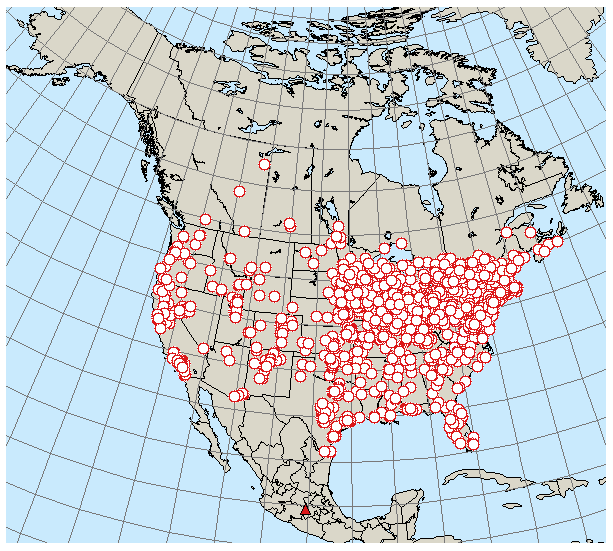
Sightings of adult Monarch butterflies as of August 25, 2016, according to Journey North. Map via Journey North
That said, climate change will have the last word on how many Monarch butterflies will make the trip this year.
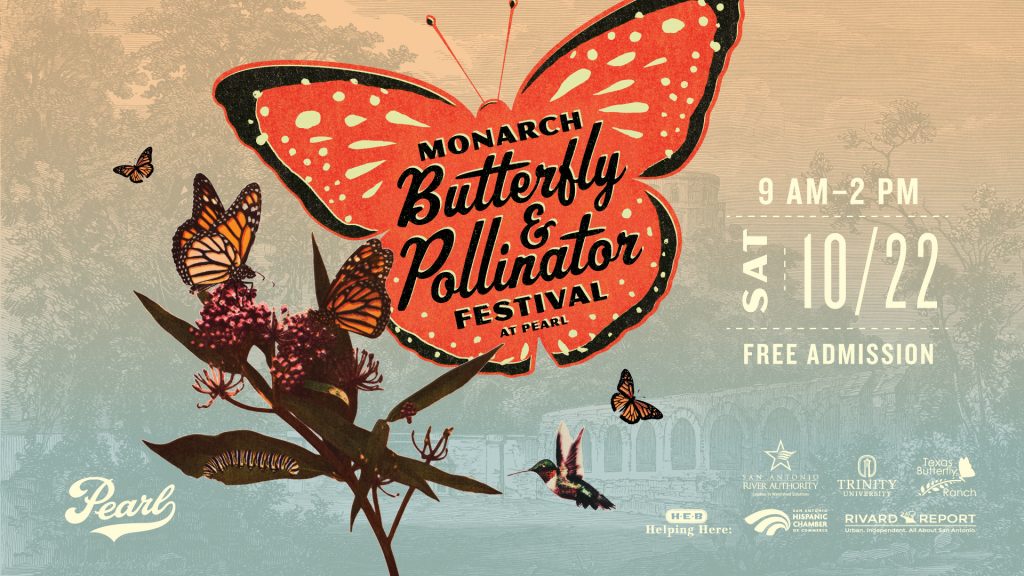
Want to be sure to see Monarchs this fall? Join us October 22 during peak Monarch migration week in San Antoino at the Monarch Butterfly and Pollinator Festival at the Pearl. Events are FREE.
Related Posts:
- Save the date! Monarch butterfly and pollinator festival at the Pearl October 22
- At least 1.5 million Monarch butterflies perish in deadly ice storm in Michoacán
- Good news! Monarch butterfly population triples
- Mighty Monarch butterflies brave south winds, Hurrican Patricia to arrive in Mexico
- Q & A Elizabeth Howard of Journey North talks tech, citizen science, butterfly releases
- Q & A: Catalina Trail, founder of the Monarch butterfly roosting sites
- 2015 a Banner Year? Monarch butterfly migration heading our way
- Q & A: Dr. Lincoln Brower on Endangered Species, Ethics, Milkweed and Monarchs
- How to tag a Monarch butterfly in Six Easy Steps
- Endangered Species Act Wrong Tool for the Job of Monarch Butterfly Conservation?
- Monarch Butterfly Inches Toward “Threatened” Status Under Endangered Species Act
Like what you’re reading? Follow butterfly and native plant news at the Texas Butterfly Ranch. Sign up for email delivery, like us on Facebook, or follow us on Twitter, @monik

Yes. Numbers are way down this year in my area (Shelby Twp. MI). I saw maybe 1-2 a month through the summer.
I had two new Monarchs to release this last week–much earlier than the three I had last year (my ranch is just a small spread in southern New Mexico). I’m hoping to see more in a second wave in September–the milkweed plants are all ready & waiting!
I’ve seen 6 monarchs today nectaring in Branford, Ct. I took the following youtube of a monarch laying eggs last Sunday. https://www.youtube.com/watch?v=UsgZd8cFJOg We’ve had normal rains throughout the monarchs Eastern range this year and it’s rained off and on all summer in Texas which is unusual. Last year it hadn’t rained since July 1 and didn’t start raining again until October. in Texas restricting the appearance of fall nectar the monarchs use as they migrate and milkweed some breed on as they move south. If the rains continue the nectar and reappearance of native milkweeds could create a large pre-migration generation this year. We now know there’s plenty of native milkweed to support 4 hectares of monarchs with milkweed left over. after last year. Chip Taylor and Elizabeth director of Journey North predicted a doubling of the population last year as late as November and the actual numbers were an increase from 1.13 hectares to over 4; almost 4x.
Live in Harrow ontaio canada…20 minutes from Point Pelee National Park where huge monarch migration take place from Southermost point of Canada. Last year we watched 72 monarchs hatch on our property adjacent to milkweed in our yard. This yeaar we have seen only 4 go into cocoon stage and 2 have harched. Milkweed infested with another furry white, black, and orange caterpillar that leaves that shiny black surface…not good for monarchs, so we capture caterpillars and have 2 n bug box in crysalis.Sad year after last year! But I keep looking..Where can I get the tiny tags ???
Article says it was climate change, in Michoacan, Mexico, last March rather than natural climate variability, that dealt a “heavy blow” to the overwintering monarchs. But no very long term historical climate data for March from that region of Mexico was presented in support the notion that any particular aspect of the early March storm was unprecedented (e.g. wind velocity, snowfall amount, hail amount, minimum temperature, etc.). Thus I consider the climate change claim unsubstantiated.
We have gathered over 200 “cats” as of 8/27. We enlarged our waystation so we are very happy with how the migration is going. We are in OIttumwa, Iowa which is at 41 deg. lat.
Great to hear Sally and Mack. Are you aware of “the beautiful monarch” facebook ? We have over 7500 citizen scientist enthusiasts raising and releasing monarchs. There’s been over 300 come on in the last month. We should hit critical mass next season. Now that we know milkweed is abundant on the landscape people are figuring out raising and releasing butterflies is the most fun, raising the most awareness, and is contributing the most to monarch and other species recovery. Keep up the great work and get your friends involved. I will be encouraging “Earl Mays” Garden Center chain to produce more butterflyweed for next season. Everyone is just digging up common runners and small plants from the ditches and transplanting them in their yards which works well too.
[…] Population loss estimates have been all over the place, with the latest estimate putting storm related deaths at 6.2 million butterflies… […]
I released 13 from the eggs & caterpillars I found in my wild milkweed that I have growing in the yard. 9/18 my last two emerged and were released. The season is about over here in MN. Last year we were able to release 19.